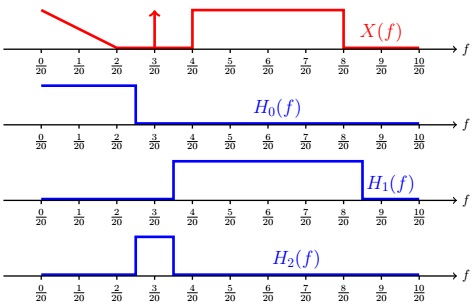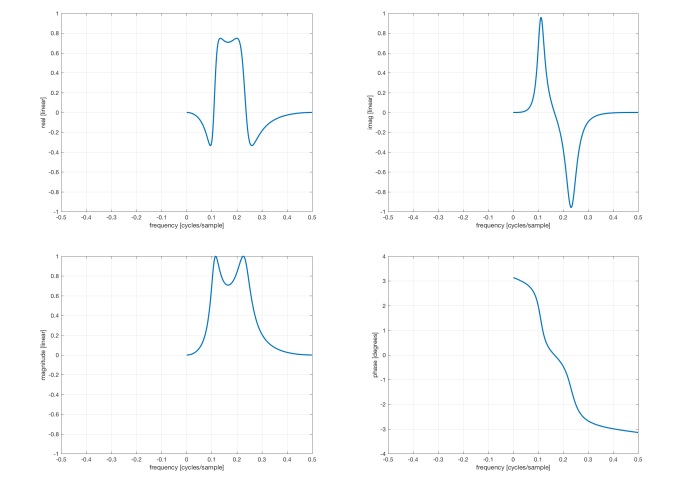Reference no: EM132462273
Discrete Signals and Time Systems Assignment
Question 1. Consider a causal, linear, time-invariant system (i.e. initially at rest) that is described by the difference equation
k=0∑N a[k]y[n - k]= k=0∑M b[k]x[n - k].
For the input signals x[n] and sets of coefficients {a[k]}Nk = 0 and {b[k]}Mk = 0 given below, do the following:
Part 1: Compute the output y[n] for n = 0, 1, 2, 3, 4, 5 by filling in the table.
|
n
|
x[n - 2]
|
x[n - 1]
|
x[n]
|
y[n - 2]
|
y[n - 1]
|
y[n]
|
|
-2
|
0
|
0
|
0
|
0
|
0
|
0
|
|
-1
|
0
|
0
|
0
|
0
|
0
|
0
|
|
0
|
0
|
0
|
|
0
|
0
|
|
|
1
|
0
|
|
|
0
|
|
|
|
2
|
|
|
|
|
|
|
|
3
|
|
|
|
|
|
|
|
4
|
|
|
|
|
|
|
|
5
|
|
|
|
|
|
|
Part 2: Check your work using Matlab's filter function.
(a) N = 0, a[0] = 1 and M = 2, b[0] = -1, b[1] = 2, b[2] = -1 and x[n]= δ[n].
(b) N = 0, a[0] = 1 and M = 2, b[0] = -1, b[1] = 2, b[2] = -1 and x[n]= u[n].
(c) N = 2, a[0] = 1, a[1] = 0, a[2] = 1 and M = 2, b[0] = -1, b[1] = 2, b[2] = -1 and x[n]= δ[n].
(d) N = 2, a[0] = 1, a[1] = 0, a[2] = 1 and M = 2, b[0] = -1, b[1] = 2, b[2] = -1 and x[n]= u[n].
Question 2. Do the following:
Part (a) Use the tableau method to convolve y[n]= h[n] * x[n] when
1, n = -18
h[n] = 2, n = -17 x[n] = Cos (2Π.1/3.n), 124 ≤ n ≤ 137
2, n = -16 137 0, otherwise
1, n = -15
0, otherwise
Specify both the values of the convolution result y[n] and the times n for which they hold.
Part (b) Check the values of the convolution result y[n]using Matlab's conv function.
Part (c) What is the length of the convolution result y[n]?
Part (d) What are the lengths of the starting and ending transients?
Part (e) What is the length of the valid part of the convolution result? (f) Compute the DTFT H(f ) of h[n].
Part (g) Using Matlab, make the following set of plots for -1 ≤ f ≤ 1:
• real and imaginary parts of H(f )
• linear magnitude |H(f )|
• log-magnitude 20 log10 |H(f )|
• ∠H(f )
Part (h) Describe the symmetry properties expected for the real and imaginary parts of H(f ).
Part (i) Describe the symmetry properties expected for the magnitude and phase of H(f ).
Part (j) Suppose the input is an everlasting complex exponential, x[n] = Cos (2Π.1/4.n) for -∞ < n < ∞. What is the output y[n]? Express your answer in the form y[n]= A cos (2Π.1/4.n + φ) In particular, what are A and φ?
Question 3. Do problem 2.54 in Oppenheim and Schafer.
Question 4. Do the following:
Part (a) Compare the DTFT X1(f ) of x1[n]= anu[- n - 1] and the DTFT X2(f ) of x2[n]= anu[n]. (Hint: X1(f )= X2(f ). Show that this is true.)
Part (b) What is the difference between X1(f ) and X2(f )? To answer this question, give conditions on a for the X1(f ) and X2(f ) to exist. This is where the two DTFTs differ.
Question 5. Consider the system pictured below with the input x[n]. The boxes labeled hi(f ) for i = 0, 1, 2 are linear time invariant systems having the impulse response indicated. A block labeled hi(f ) performs convolution in the time domain with the impulse response hi[n]. The box labeled (·)2 outputs the square of the input with that operation being performed in the time domain. The circle labeled x multiplies two signals in the time domain. Let Hi(f ) denote the frequency response of the LTI system having impulse response hi[n] for i = 0, 1, 2.

Assume that the input signal x[n] is a real-valued signal. The spectrum (DTFT) X(f ) of x[n] is given below along with the frequency responses of the filters. Assume that the filters have unity gain in their pass bands.

Sketch the spectra (DTFT) for - 1/2 ≤ f ≤ 1/2 at the points indicated below. Use the graph paper provided. Focus your attention on the position and shape of the spectra. Don't worry about the spectral amplitudes.
(a) Y1(f )
(b) A(f )
(c) B(f )
(d) C(f )
(e) D(f )
(f) E(f )
(g) Y0(f )
Question 6. What is the impulse response h[n] of the band-stop filter having frequency response
H(f) = 1, 0≤|f|≤0.2
H(f) = 0, 0.2≤|f|≤0.3
H(f) = 1, 0.3≤|f|≤0.5
Express your answer in terms of sinc functions.
Question 7. If x[n]= x*[n] is a real-valued sequence, then the DTFT X(f ) has Hermitian symmetry, X(f )= X*( f ). Decompose X(f ) into its real and imaginary parts,
Xr(f )= 1/2 [X(f )+ X*(f)]
X(f )= Xr(f )+ jXi(f ),
Xi(f )= 1/2j [X(f ) - X*(f )]
(a) Prove that the real part is even, Xr(f )= Xr(-f).
(b) Prove that the imaginary part is odd, Xi(f )= -Xi(-f ).
(c) Prove that the magnitude is even, |X(f )| = |X(-f )|.
(d) Prove that the phase is odd, ∠X(f )= -∠X(-f ).
(e) For real sequences x[n], explain why it is sufficient to visualize the DTFT X(f ) for only positive frequencies, 0≤f≤0.5.
(f) Suppose x[n] is real and consider the partial plots of Xr(f ), Xi(f ), |X(f)|, and ∠X(f ) for 0 < f < 0.5 shown below. Given the symmetry requirements on X(f ), sketch the real part, imaginary, part, magnitude, and phase for -0.5 <x< 0.

Question 8. Consider the signals
x[n]= anu[n],
w[n]= 1, 0≤n≤20
w[n]= 0, otherwise
y[n]= w[n]x[n].
The spectra X(f ) (left), W (f ) (middle), and Y (f ) (right) are shown below.

Use the multiplication property of the DTFT to explain the shape of Y (f ).
Question 9. Consider the signals below:
x[n] = cos (2Πf0n) , -∞ < n < ∞,
w[n]= 1, -N≤n≤N
w[n]= ,0, otherwise
y[n]= x[n].w[n].
Sketch the linear (not dB) magnitude spectra of x[n], w[n], and y[n] for f0 = 1/4 and N = 10. (You may use a Matlab plot in stead of a sketch.) Use the multiplication property of the DTFT to explain the shape of |Y (f )|.
Question 10. Consider the signals below:
x[n]= (sin(Π(2f0)n))/Πn , -∞ < n < ∞,
w[n]= 1, -N≤n≤N ,
w[n]= 0, otherwise
y[n]= x[n] . w[n].
Sketch the linear (not dB) magnitude spectra of x[n], w[n], and y[n] for f0 = 1/4 and N = 10. (You may use a Matlab plot in stead of a sketch.) Use the multiplication property of the DTFT to explain the shape of |Y (f )|.